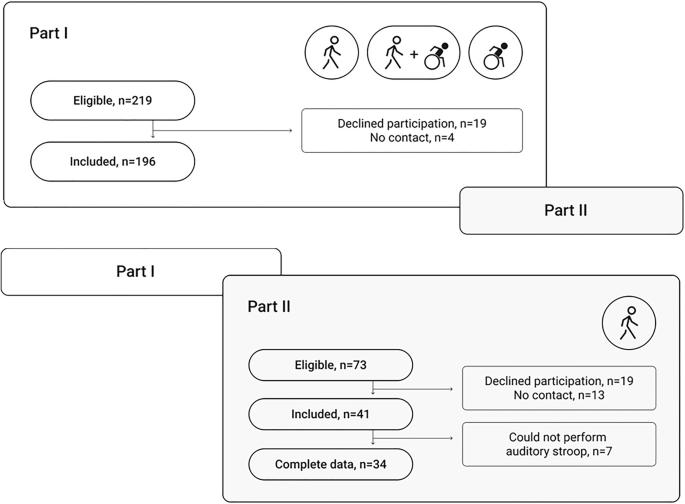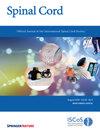Motor-cognitive interaction in adults with spina bifida: dual-task effects
IF 2.2
4区 医学
Q3 CLINICAL NEUROLOGY
引用次数: 0
Abstract
Cross-sectional design. To study motor-cognitive interaction during walking while performing a cognitive task (dual-task [DT]) in ambulatory adults with spina bifida (SB). A specialized spinal cord center, The Spinalis clinic at Aleris Rehab Station Stockholm, Sweden. Assessments of muscle strength and ambulatory function were performed. Gait was assessed with a sensor-based system with/without the auditory Stroop. Timed-up-and-go (TUG) with/without a cognitive task was also assessed. Regarding cognitive function, episodic memory, executive function, and processing speed were assessed. The percentage of difference between single-task (ST) and dual-task (DT) was used to calculate the DT effect (DTE) as cost or benefit. Differences were analyzed with t-test and Wilcoxon’s signed rank test. Forty-one persons were included, mean age 37 years (SD 12) and 20 (49%) were women. Thirty-four completed the DTE analysis. Seven could not perform the cognitive task and/or gait data and could not be registered. There was a DT cost on gait speed (4%), stride length (3%) and double support phase (3%), and cognitive function showed a cost of 3%. DTE for TUG was a 26% cost. We showed a DT cost on gait, possibly indicating fall risk during DT walking. The largest DT cost was seen during TUG with a cognitive task, indicating a valuable clinical test for motor-cognitive performance for adults with SB. This study is pioneering in that it increases our understanding of DT performance in ambulatory adults with SB which could facilitate development of targeted rehabilitation interventions and self-management strategies.

成人脊柱裂的运动-认知相互作用:双任务效应。
研究设计:横断面设计。目的:研究脊柱裂(SB)患者在行走时执行认知任务(双任务[DT])时的运动-认知相互作用。设置:一个专门的脊髓中心,在Aleris康复站的脊柱诊所斯德哥尔摩,瑞典。方法:评估肌肉力量和运动功能。步态评估采用基于传感器的系统,有/没有听觉Stroop。在有/没有认知任务的情况下,还评估了“计时出发”(TUG)。在认知功能、情景记忆、执行功能和处理速度方面进行了评估。采用单任务(ST)和双任务(DT)之间的差异百分比来计算DT效应(DTE)作为成本或收益。差异分析采用t检验和Wilcoxon符号秩检验。结果:纳入41例,平均年龄37岁(SD 12),女性20例(49%)。34例完成了DTE分析。7人不能执行认知任务和/或步态数据,无法注册。步态速度(4%)、步幅(3%)和双支撑阶段(3%)有DT成本,认知功能的DT成本为3%。TUG的DTE成本为26%。结论:我们显示了DT对步态的影响,可能表明DT行走时跌倒的风险。在认知任务的TUG中观察到最大的DT成本,这表明对SB成人运动认知表现的临床测试是有价值的。这项研究的开创性之处在于,它增加了我们对SB动态成人运动认知表现的理解,可以促进有针对性的康复干预和自我管理策略的发展。
本文章由计算机程序翻译,如有差异,请以英文原文为准。
求助全文
约1分钟内获得全文
求助全文
来源期刊

Spinal cord
医学-临床神经学
CiteScore
4.50
自引率
9.10%
发文量
142
审稿时长
2 months
期刊介绍:
Spinal Cord is a specialised, international journal that has been publishing spinal cord related manuscripts since 1963. It appears monthly, online and in print, and accepts contributions on spinal cord anatomy, physiology, management of injury and disease, and the quality of life and life circumstances of people with a spinal cord injury. Spinal Cord is multi-disciplinary and publishes contributions across the entire spectrum of research ranging from basic science to applied clinical research. It focuses on high quality original research, systematic reviews and narrative reviews.
Spinal Cord''s sister journal Spinal Cord Series and Cases: Clinical Management in Spinal Cord Disorders publishes high quality case reports, small case series, pilot and retrospective studies perspectives, Pulse survey articles, Point-couterpoint articles, correspondences and book reviews. It specialises in material that addresses all aspects of life for persons with spinal cord injuries or disorders. For more information, please see the aims and scope of Spinal Cord Series and Cases.
 求助内容:
求助内容: 应助结果提醒方式:
应助结果提醒方式:


